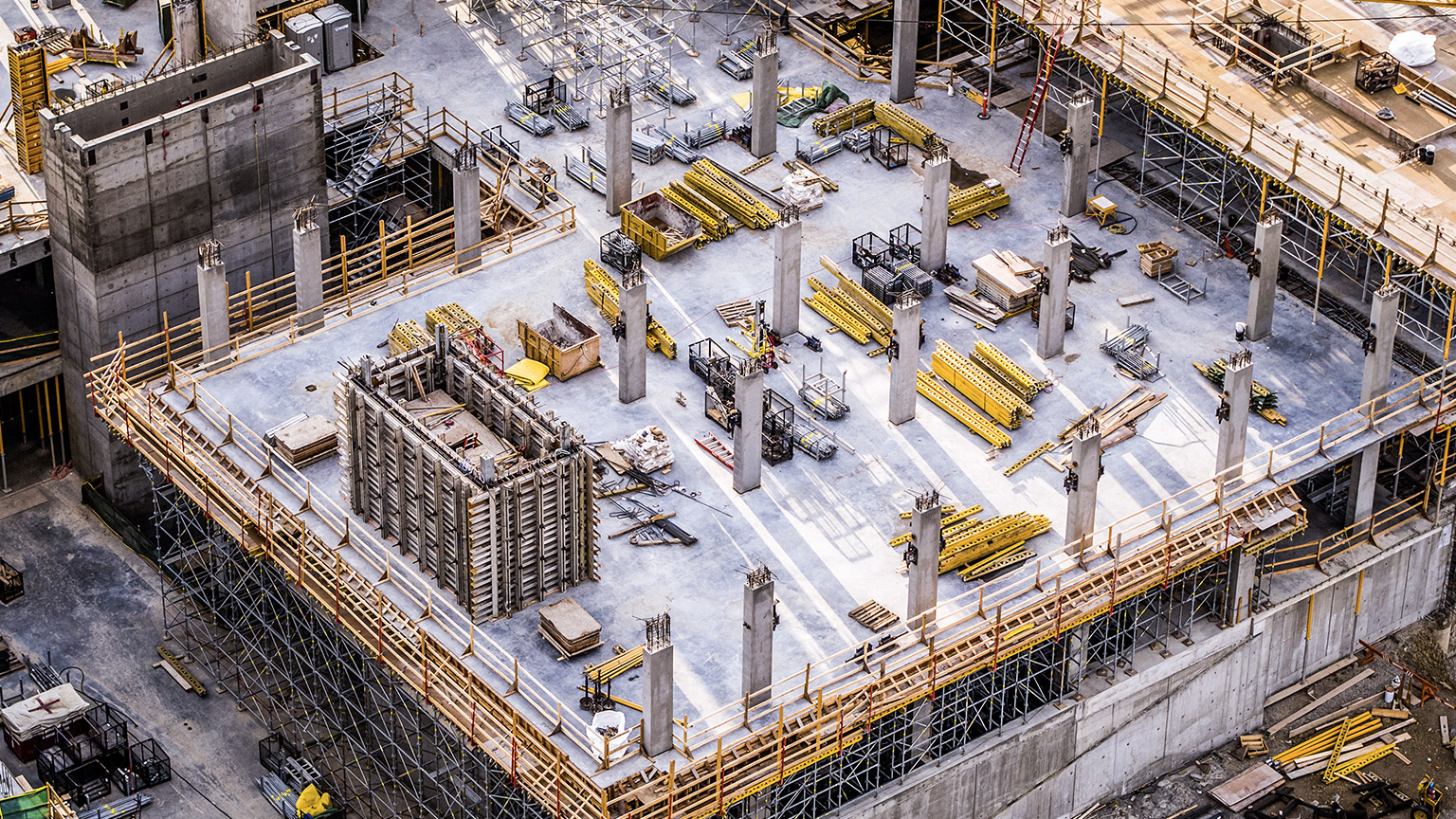In assessing workplace risk, the first thing you should examine is the workplace itself, the construction site. Regardless of the nature of the project, construction sites generally have potential risk areas that may cause harm to your workers and stakeholders if not properly addressed.
Risk management process
In simple terms, risk management is doing whatever you can to eliminate or to minimise health and safety risks from arising in a workplace. The risk management process involves four primary steps that you should follow in order to eliminate or manage risk on the construction site.
These are the four (4) steps of the Risk Management Process:
Although risk management includes all these steps, chances are that there will be some hazards and risks not accounted for. New hazards, as well as modified ones, and their corresponding risks can appear. And negligence of this will mean danger and harm to your workers and stakeholders. Therefore, you must remember to consistently carry out the risk management process to provide a safe and productive project.
Risk assessment

As discussed, risk assessment means measuring the risk of a hazard that is present in the workplace, the construction site, essentially evaluating the safety of the construction site. It involves considering what could happen to a person exposed to a hazard (consequence) and the probability (likelihood) of the hazard happening. A risk assessment will help your project by determining the following:
- Cause of the hazard and/or risk.
- Severity of the risk.
- Effectiveness of any existing control measure.
- Actions to be taken to control the risk.
- Urgency to control the risk.
A risk assessment should be done when:
- There is uncertainty about how a hazard may result in injury or illness.
- The work activity involves a number of different hazards and there is a lack of understanding about how the hazards may interact with each other to produce new or greater risks.
- Changes at the workplace occur that may impact the effectiveness of existing control measures.
Conducting a risk assessment
You should remember that hazards can cause multiple types and degrees of harm. For example, wires on a walkway can cause tripping or even falling to those using the walkway. The same wires can also bring risk of electrocution to a person, especially if the wire is exposed or wet. This means that, when assessing risks, you should take everything into consideration, from the nature of the hazard, to its location, to the people exposed to it.
The two main processes in assessing risk in the workplace include:
- Identifying the risks (severity and likelihood)
- Rating the risks (risk matrix and risk register)
Identifying the risks
In most cases, incidents occur as a result of a chain of events and a failure of one or more links in that chain. If one or more of the events can be stopped or changed, the risk may be eliminated or reduced.
One way of working out the chain of events is to determine the starting point where things begin to go wrong and then consider: ‘If this happens, what may happen next?’ This will provide a list of events that sooner or later cause harm.
In thinking about how each hazard may cause harm, you should take into consideration the following:
- The effectiveness of existing control measures and whether they control all types of harm.
- How work is actually done, rather than relying on written manuals and procedures.
- Infrequent or abnormal situations, as well as how things are normally meant to occur.
To assess risks of hazards, here are two things to consider in determining the risks associated with a hazard:
- The severity of the harm (Consequence): To assess the severity of harm associated with each hazard you should consider the following questions:
- How severe is the harm? Check if the hazard has the potential to cause death, serious injuries, illness or only minor injuries.
- What factors could influence the severity of harm that occurs? For example, the height from which a person might fall would affect the severity of the injury.
- Is the harm immediate or gradual? Some hazards like slips and falls cause immediate harm while others tend to cause more gradual harm, such as hearing damage due to constant exposure to noise over time.
- Are specific tools/procedures needed to assess the severity of the harm? This may involve laboratory tests and other tests like assessing the amount of noise exposure.
- How many people are exposed to the hazard? Consider the number of people that can be affected. For example, an explosion in a construction site may cause injury to many people including those outside the work area.
- Could one failure lead to other failures? For example, could the failure of your electrical supply make any control measures that rely on electricity ineffective?
- Could a small event escalate to a much larger event with more serious consequences? For example, a minor fire can get out of control quickly in the presence of large amounts of combustible materials.
- The likelihood of harm occurring: The likelihood or chances of harm can be assessed by considering the following questions:
- How often is the task done? Does this make the harm more or less likely?
- How often are people near the hazard? How close do people get to it?
- Has it ever happened before, either in your workplace or somewhere else? How often?
Identifying potential risk areas
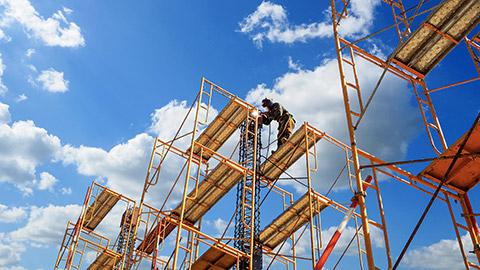
Risk assessment is the method you should use to help identify potential risk areas on site. In Australia, there are construction works considered high-risk based on the Work Health and Safety Regulations 2011 (WHS Regulation). Specifically, high-risk construction work:
- Involves a risk of a person falling more than 2 metres.
- Is carried out on a telecommunication tower.
- Involves demolition of a load-bearing element of a structure.
- Involves, or is likely to involve, disturbing asbestos.
- Involves alteration/repair that requires temporary support to prevent collapse.
- Is carried out in or near a confined space.
- Is carried out in or near a shaft or trench deeper than 1.5 m or a tunnel.
- Involves the use of explosives.
- Is carried out on or near pressurised gas mains or piping.
- Is carried out on or near chemical, fuel or refrigerant lines.
- Is carried out on or near energised electrical installations or services.
- Is carried out in an area that may have a contaminated or flammable atmosphere.
- Involves tilt-up or precast concrete.
- Is carried out on, in or adjacent to a road, railway, shipping lane or other traffic corridor in use by traffic other than pedestrians.
- Is carried out in an area of a workplace where there is any movement of powered mobile plant.
- Is carried out in areas with artificial extremes of temperature.
- Is carried out in or near water or other liquid that involves a risk of drowning.
- Involves diving work.
At the end of the module, at the Additional Resources, you can access a risk assessment template and risk assessment examples provided to see how a risk assessment can be done. The examples provided are for brick layering and carpentry.
Workplace inspections
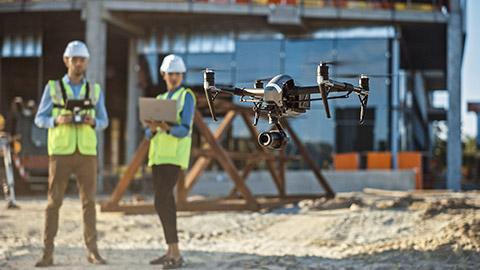
Take note, though, that there may be potential risks areas that are not considered as high-risk construction work. They might not need licences or safe work method statements but can still pose a high risk of harm to workers and should still be controlled. To determine these potential risk areas, you must conduct a workplace inspection on the construction site.
General workplace inspections are must to have procedures to help identify hazards and their risks. Unlike risk assessments which are usually performed by those in the project, workplace inspections are performed by health and safety workers and representatives as well as work health and safety practitioners. They critically examine the workplace and take note of potential hazards and risk areas so that they can be eliminated or avoided. Therefore, it is important that you schedule regular workplace inspections to proactively identify, assess and eliminate (or control) hazards and their risk of harm.
At the end of the module, at the Additional resources, you can access a Site Inspection Report template provided by WorkSafe Queensland.

Health monitoring
As defined by the Work Health and Safety Regulations, health monitoring of person means monitoring the person to identify changes in the person’s health status because of the exposure of certain substances. A general level of fitness for work is also necessary because construction work can be physically demanding. Therefore, it is also important to monitor the level of fitness to ensure the worker’s ability to perform the job properly.
Assessing the site worker’s health through health monitoring is highly recommended, and it is even a requirement under the WHS Regulation for specific scenarios, such as when handling hazardous chemicals that are likely to appear in construction work, such as lead and asbestos.
The employer is the one who has the duty to monitor the health of the workers in the following instances:
Construction companies often require a pre-employment medical examination to ensure employees can meet the demands of a specific job role. They are especially useful in roles that are typically regarded as high risk due to various physical, environmental or situational factors.
A pre-employment medical examination may include:
-
Drug and alcohol screenings
-
Hearing tests
-
Vision tests
-
Driving assessments
-
General fitness tests.
Significant risk
To assess the site workers’ safety, it is also necessary to determine if the risk to your workers is significant and health monitoring is required. In deciding if a certain risk is significant, your employer, project officers or health and safety officers should consider the following:
- The nature and severity of the hazard for each hazardous chemical.
- The degree of exposure to workers.
Once the project or health and safety team has assessed and determined that there is significant risk, they should provide you with the information that led to the decision.
Workers’ mental health and welfare

Mental welfare is a state where workers are mentally healthy and are capable of coping with the demands of the workplace. On a construction site, workers’ mental welfare means that they are healthy enough to keep up with the physical demands of construction work, the constant possibility of serious injuries, and other consequences of the type of work.
Seasonal jobs, long hours, long commutes, time away from family and exhaustion are just a few of the conditions that can trigger a mental health illness. These triggers, however, are sometimes every day factors for construction workers.
Bullying, harassment and strained relationships in the workplace can be also detrimental to someone’s mental health, it may cause depression that may even lead to suicide attempts.
Bullying may seem like rough jokes at times; however, it is a breach of the Fair Work Act 2009 and it may lead to serious consequences.
Examples of bullying include:
- Behaving aggressively
- Teasing or practical jokes
- Pressuring someone to behave inappropriately
- Any uninvited and harmful physical contact
- Intimidation
- Threatening
- Ganging up on a worker
- Excluding someone from work-related events
- Unreasonable work demands3.
From a legal perspective, Section 789FD of the Fair Work Amendment Act 2013 considers a worker to have been ‘bullied’ in cases where:
- An individual or group of individuals repeatedly behaves unreasonably toward either the individual worker or a group of workers of which the employee is a member; and
- That behaviour creates a risk to health and safety.4
If someone experiences bullying at a worksite, they should report it to their supervisor and follow organisational procedures. Employees may also seek assistance from the Fair Work Commission (the Commission) that is the national workplace relations tribunal that deals with anti-bullying claims under the Fair Work Act.
In the workplace, mental health problems are not only caused by work-related factors; although work is a contributing factor, it is not the only reason why workers in the construction industry need mental health first aid. First aid is to be given until a worker has received professional treatment. In assessing a person with a mental health problem, it is necessary to know the signs, know what is not helpful, and be supportive. Note that diagnosis is only done by trained professionals, but it is vital to stay alert to changes in a person's mood, behaviour, energy, habits, or personality.
To help workers regarding their mental health and welfare, you should provide your project with a mental health first aid officer on site, just like first aid officers for physical injuries. Mental Health First Aid officers are trained under the Mental Health First Aid Australia, an organisation that develops and assesses relevant courses, as well as trains people to carry out mental health first aid. As they specialise in mental health first aid, they can provide consultations and assistance to workers needing help for their mental health and well-being.
For many people, the COVID-19 pandemic has introduced and increased a range of psychosocial hazards in the workplace, at a time when a range of other non-work related psychosocial risks are also occurring (uncertainty about future employment, social isolation etc.).5
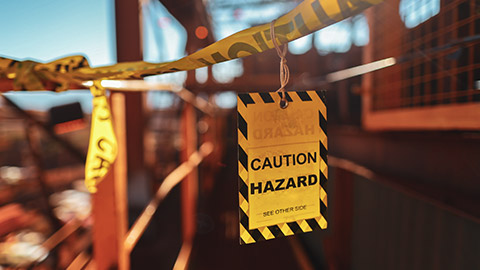
Hazard identification
Hazards are defined as situations or things that have the potential to inflict harm on a person. In the construction industry, there are plenty of circumstances and objects that can harm construction workers when carrying out construction work. These hazards bring the risk of harming someone. Therefore, you need to be able to identify hazards in order to manage the risk they bring to the site.
Identifying hazards on a construction site means finding things and situations that could potentially cause harm to the people on site or outside the site. These hazards may arise from different aspects of work, such as:
- Physical work environment
- Resources used (equipment, materials, substances and human resources)
- Work tasks (and how they are performed)
- Work design and management.
For example, some hazards are part of the work process, such as mechanical hazards, noise, or toxic properties of substances. Other hazards result from equipment or machine failures and misuse, chemical spills, and structural failures, or where work demands exceed a worker’s ability to cope. Take note also that an aspect of construction work may have multiple hazards.
Types of hazards
There are various types of hazards present in a workplace. Different types of hazards will have different types of harm they can cause. General types of hazards, with their specific examples, found in the workplace include:
| Types of hazards | Examples |
|---|---|
| Manual tasks | Tasks involving sustained or awkward postures, high or sudden force, repetitive movements or vibration |
| Gravity | Falling objects, falls, slips and trips of people |
| Psychosocial | Excessive time pressure, bullying, violence and work-related fatigue |
| Electricity | Exposure to live electrical wires |
| Machinery and equipment | Being hit by moving equipment, or being caught in moving parts of machinery |
| Hazardous chemicals | Acids, hydrocarbons, heavy metals, asbestos and silica |
| Extreme temperature | Conditions relating to heat and cold |
| Noise | Consistent exposure to loud noises |
| Radiation | Ultraviolet rays, welding arc flashes, microwaves and lasers |
| Biological | Exposure to micro-organisms, viruses |
As an example, the table below lists down examples of hazards found when performing construction work, as well as their potential harm to people.
| Construction Work | Potential Hazard | Potential Harm |
|---|---|---|
| Crane operation | Crane height, weight of crane’s load, structural failure | Concussions, physical injuries |
| Dogging and rigging | Weight and centre of gravity of load, failure of load support | Physical strain, injuries, concussion from falling objects |
| Concrete pumping | Noise and oscillation (from equipment), exposure to wet concrete and silica dusts, equipment failure/collapse | Hearing damage, respiratory illnesses, skin diseases, physical injuries, strain and fatigue |
| Tilt-up panel construction | Combined hazards listed at concrete pumping, lifting and crane operation | Concussion, physical injuries |
| Scaffolding | Scaffold collapse, fall from height, falling objects | Physical injuries |
| Operation of plant and equipment | Moving parts, sharp parts of plant and equipment | Physical injuries |
| Demolition | Structure collapse, fall from height, falling debris, exposure to hazardous materials and air contaminants | Physical injuries, respiratory illnesses, skin diseases |
| Asbestos removal and exposure to asbestos fibres | Inhalation or ingestion of asbestos fibres | Respiratory illnesses, skin diseases, eye damage |
| Exposure to silica | Inhalation or ingestion of silica dust | Respiratory illnesses, skin diseases, eye damage |
| Airborne contaminates | Exposure to or inhalation of contaminants (e.g. dust, vapours, fumes, carbon monoxide) | Respiratory illnesses, skin diseases, eye damage |
| Exposure to excessive noise | Volume of noise, duration of exposure to noise | Hearing loss, migraine |
| Electrical work | Exposure to live electrical wires/power lines, presence of nearby flammable materials | Shock, burns, organ damage |
| Working at heights | Fall from height, failure of harness system/guardrails | Physical injuries |
| Hazardous materials and substances | Acids, heavy metals, toxic agents | Burn, skin illnesses, respiratory illnesses |
| Working in confined spaces | Poor ventilation and lighting, entrapment | Eye strain and damage, difficult breathing to asphyxiation, physical strain, psychological stress |
To access Model Codes of Practices, visit SafeWork Australia’s website or the relevant state/territory’s webpage.
Determining control measures
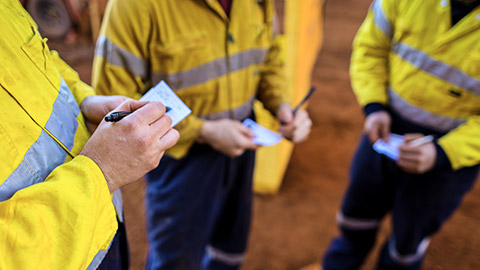
Once you have identified the hazards in the construction site and assessed the risks those hazards bring, you should now control these risks. Risk control involves determining the appropriate control measure to be used to eliminate or minimise the risk of a hazard.
It is important to note that you must consult your workers and their representatives when deciding which control measures as they are directly affected by these measures. Their experience will help you choose the right control measures. Likewise, their involvement will increase the level of acceptance of any changes that may be needed to the way they do their job.
Hierarchy of control measures
Before commencing tasks, all foreseeable hazards (for example, falling off a roof, falling objects) and actual risks (e.g. death, serious injury) should be identified and appropriate safety measures put in place (e.g. install guard railing, prevent access under a roof being constructed). Control measures are selected by working through the 6 steps (or levels) of the Risk Control Hierarchy, from 1 to 6. Work sites often use the following structure to provide and maintain a safe work environment. The structure of the pyramid tells any person which control measure is most effective (in almost every situation), and which should be chosen first.
Level 1: Elimination
Eliminating the risks and hazards they create entirely is the most effective control.
Level 2: Substitution
Identify an alternative that does not involve or reduce the risks.
Level 3: Isolation
Isolate the risk to reduce its impact on people.
Level 4: Engineering controls
Adapt tools, equipment or engineering procedures to remove or reduce the risk.
Level 5: Administrative controls
Change work practices to minimise exposure to the risks or reduce the chance of injury.
Level 6: Personal Protective Equipment (PPE)
Use PPE to protect people from harm.
Some control measures are more effective than others. Control measures can be ranked from the highest level of protection and reliability to the lowest. This ranking is known as the hierarchy of control.
Eliminating the risk
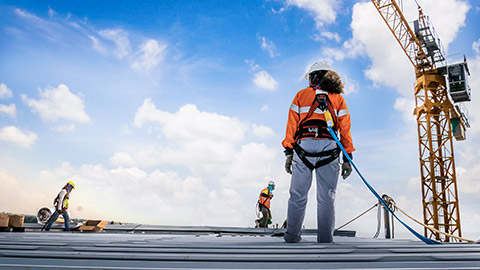
This means removing the hazard or hazardous work practice from the workplace. This is the most effective control measure and must always be considered before anything else. For example, eliminate the risk of a fall from a height by doing the work at ground level.
If elimination of the risk is not reasonably practicable, you must consider using substitution, isolation or engineering controls, or a combination of these control measures, to minimise the risk.
Substitution
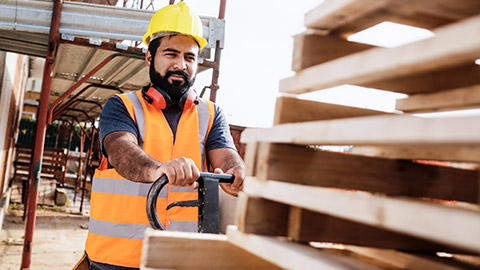
Minimise the risk by substituting or replacing a hazard or hazardous work practice with a less hazardous one. For example:
- Substituting a manual task of carrying tools from one level to another with a material hoist or craning material will minimise the risk of workers developing a musculoskeletal disorder.
- Substituting a two-part epoxy substance with a water-based acrylic waterproofing system will minimise exposure to a hazardous substance.
- Substituting an ordinary brick-cutting saw blade with a noise-reduced saw blade will minimise exposure to hazardous noise.
Isolation

Minimise the risk by isolating or separating the hazard or hazardous work practice from people.
For example, isolating a mobile plant work zone from workers and/or the public with physical barriers will minimise the risk of contact occurring between a person and the mobile plant.
Engineering
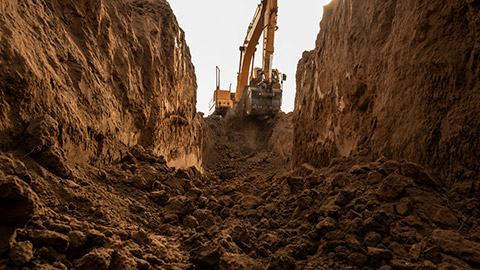
Controls Engineering controls are physical control measures to minimise risk. For example: Benching, battering or shoring the sides of the excavation will minimise the risk of a person being trapped and prevent the excavation from collapsing.
Enclosing an open cab excavator, for example, using a falling object protective structure (FOPS) or a roll-over protective structure (ROPS), will minimise the risk of an operator being struck by a falling object or being crushed if the excavator rolls over.
Administrative controls
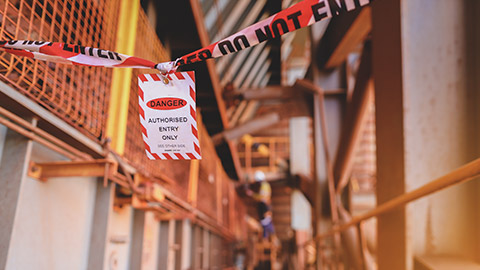
Administrative controls should only be considered when other higher order control measures are not practicable, or to increase protection from the hazard. These are work methods or procedures that are designed to minimise the exposure to a hazard, such as ensuring there is no unauthorised entry of a person to a work area. For example:
- Using a ‘keep out’ sign and a person to secure an exclusion zone when dismantling scaffolding to minimise the risk of people entering the work area and being struck by a falling object.
- Implementing a training program to show workers how to use new equipment.
- Implementing a job rotation system.
- Using permit systems to prevent unauthorised persons from entering a confined space.
Personal Protective Equipment (PPE)
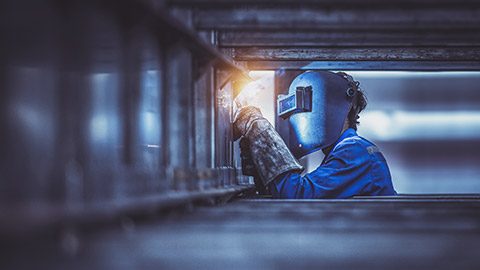
PPE is the lowest order control measure in the hierarchy of controls. PPE should also only be considered when other higher order control measures are not reasonably practicable or to increase protection from the hazard.
PPE relies on the proper fit and use of the PPE and does nothing to change the hazard itself. It therefore requires thorough training and effective supervision to ensure compliance and effectiveness.
Here’s a list of common PPEs used at a construction site:
- Hard hat: Hard hats help to protect a worker's head from falling debris, low-hanging beams, and other incidents that may result in a dangerous knock to the head. Hard hats are a crucial piece of PPE, since rubble and other hazardous items are present on all construction sites and could cause significant injuries to workers.
- Steel cap work boots: Steel cap boots protect your feet and ankles from heavy falling objects, trauma, uneven surfaces, and so on. Steel cap work boots also help to support your feet during long work hours on the construction site.
- Hand protection: Gives protection from both physical and chemical hazards. Gloves should conform to Australian Standards (AS/NZS 2161.1:2000)
- Safety glasses/face shields when operating power tools and machinery: The design of eye and face protection has to conform to a standard ( AS/NZS1337 ) AS/NZS 1336 (Recommended practices for occupational eye protection), 1337 (Occupational eye protectors). The selection of the correct eye protection to protect against multiple hazards on the work site is important. Face shields give full face protection as well as eye protection. They should be worn with approved safety glasses.
- High visibility reflective clothing or vests: The garments specified in AS/NZS 4602:1999 High Visibility Safety Garments are Earplugs or earmuffs to minimise the risk of exposure to excessive noise when operating noisy machinery and power tools. The two main types are ear muffs and earplugs. Choose the one that’s best suits you and still conforms to the standard (AS/NZS1270) Acoustic hearing protectors.
- Wide-brimmed hats (where hard hats are required then it should be a hard hat brim or neck flap). Approved sunglasses and sunscreen to minimise the exposure to ultraviolet (UV) radiation.
It is important that you ask your site supervisor about the additional PPE that may be required for your work site, to ensure that you aren't missing any valuable pieces that could protect you from potential hazards. For example, if the construction site you are working on is particularly loud, you may need earplugs to prevent damage from occurring to your eardrums. To ensure you are using the right PPE for your work site, you should consult the model Code of Practice (Construction work) (2018) published by SafeWork Australia. Model Code of Practices get updated regularly.
Determining the control measures to be used
Once hazards and their associated risks have been identified and assessed, you should now consider on the control measures to be used to eliminate or minimise the risks of hazards. In general, the controls you choose should be those that:
- Are most reliable to provide the highest level of protection for people (i.e. controls located towards the top of the hierarchy).
- Are available, meaning it can be purchased, made to suit or be put in place.
- Are suitable for the circumstance in your workplace and will properly work given the workplace conditions, work process and your workers.
When a hazard with the potential to cause death, serious injury or illness is present in the workplace, this hazard should be given controls that will eliminate or reduce the level of harm it may cause, as opposed to decreasing the likelihood of occurring. Also, ensure that control measures, when implemented, do not introduce new hazards on site. If this is not possible, see to it that these new hazards (and their risks) go through risk management as well.
One factor affecting the determination of control measures to be used in the workplace is the cost of the control, in terms of money, time and effort. As projects only function on an agreed and limited budget, the cost of a control measure helps decide if it is worthy of implementation, especially when there are various options of control measures that can be applied.
The general rule, though, is that the greater the likelihood of harm occurring or the more severe that harm can cause, the less weight you should give to the cost of control measures that will eliminate or minimise the risk.

WHS legislation covers all the WHS acts and regulations enacted by the States and Territories of Australia. The WHS Legislation comprises of the Work Health and Safety Act 2011 and the Work Health and Safety Regulations 2011. Both pieces of legislation provide legal requirements for construction projects to comply with. Therefore, familiarisation is a must to be able to determine these requirements.
Work Health and Safety Act 2011 (WHS Act)
The WHS Act defines the broad policies regarding health and safety standards that should be apparent in the project, promoting the welfare, health, and safety of those who are in the construction project. The current WHS Act aims to harmonise the jurisdictional WHS laws so that work health and safety is nationally consistent between States and Territories, as they enact and enforce them under their jurisdiction.
Work Health and Safety Regulation 2011 (WHS Regulations)
The WHS Regulation 2011 is a set of regulatory guidelines stemming from the WHS Act 2011. The regulation sets out specific requirements to be met with regards to a wide range of matters relation to work health and safety, including construction work.
States and territories of Australia have their own work health and safety legislation based on the model WHS Act and WHS Regulation developed by Safe Work Australia. This helps with the aim of creating a consistent WHS standard across the country.
To help you identify the current WHS legislation covering your project, the map below includes the WHS Act and WHS Regulation of the states and territories of Australia as well as their respective regulatory body for work health and safety.
The regulations provide guidance around many aspects of working safely, for example around the duty of identifying hazards (Regulation 34), hierarchy of control measures (Regulation 36), duty to provide first aid (Regulation 42), managing risk of hearing loss from noises (Regulation 57), emergency procedures (Regulation 74) in the following state regulations:
- Work Health and Safety Regulation 2011 (ACT)
- Work Health and Safety Regulation 2017 (NSW)
- Work Health and Safety (National Uniform Legislation) Regulations 2011 (NT)
- Work Health and Safety Regulations 2011 (QLD)
- Work Health and Safety Regulations 2012 (SA)
- Work Health and Safety Regulations 2012 (TAS)
Australian Standards
Australian Standards contain quality and up-to-date guidelines and specifications for certain industries and businesses, including construction work, in the country. These Standards are not mandatory but are recommended to ensure high-quality construction work and processes. Although there are instances where Standards are referenced in national and jurisdictional legislation, therefore requiring compliance with the Standards. According to a testimonial on Standards Australia’s website, Standards complement the National Construction Code which ensures the public’s safety, health and amenity. Without these standards, this cannot be achieved.6
Australian Standards provide guidance around WHS items. For example:
| WHS item | Standard |
|---|---|
| Eye and face protection - Guidelines | AS/NZS 1336:2014 |
| Personal eye protection - Eye and face protection - Vocabulary | AS/NZS 1337.0:2014 |
| Respiratory protective devices | AS/NZS 1716:2012 |
| Occupational noise management | AS/NZS 1269 (R2016) |
| Occupational protective helmets | AS/NZS 1801:1997 |
| Occupational protective gloves | AS/NZS 2161.1:2016 |
| Safety, protective and occupational footwear - Guide to selection | AS/NZS 2210.1:2010 |
| Portable ladders - Selection, safe use and care | AS/NZS 1892.5:2000 |
| Safety signs for the occupational environment | AS1319-1994 (R2018) |
Australian Standards also provide guidance around how certain construction tasks should be typically performed. For example:
| No. | Date | Title |
|---|---|---|
| AS/NZS ISO 717 | 2004 | Acoustics — Rating of sound insulation in buildings and of building elements — Airborne sound insulation |
| AS ISO 717 Part 2 | 2004 | Acoustics — Rating of sound insulation in buildings and of building elements — Impact sound insulation |
| AS 1056 Part 1 | 1991 | Storage water heaters — General requirements (incorporating amendments 1, 2, 3, 4 and 5) |
| AS/NZS 1170 | 2002 | Structural design actions — General principles (incorporating amendments 1, 3 and 4) |
| AS/NZS 1170 | 2011 | Structural design actions — Wind actions (incorporating amendments 1, 2, 3, 4 and 5) |
| AS 1191 | 2002 | Acoustics — Method for laboratory measurement of airborne sound transmission insulation of building elements |
| AS 1273 | 1991 | Unplasticized PVC (UPVC) downpipe and fittings for rainwater |
| AS 1288 | 2006 | Glass in buildings — Selection and installation |
At the end of the module, at the Additional Resources, you can find a full list of construction-related Australian standards.
Australian Standards for different industries, including building and construction, can be purchased via Standards Australia Webstore, powered by Techstreet, and via SAI Global7.
Complying with organisational policies
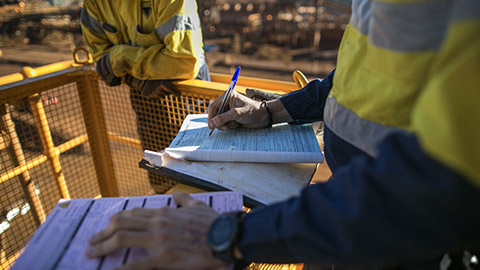
Organisational policies are courses of actions adopted by your organisation and provide your workers organisational standard on how to work and conduct themselves. Thus, it is important that control measures not only comply with legal requirements, but also with organisational policies. Certain WHS policies in an organisation have specific rules or procedures to follow. These procedures make it safe for workers when they are in a construction site. For example, proper dress code policy (administrative control) is usually implemented, aside from PPE usage. Shorts, casual footwear, accessories, etc., are typically prohibited to make sure that a worker is not exposed to hazards on site and so that they do not hinder construction work.
Organisations will most likely have policies on risk management. This will include duties and responsibilities of those involved in risk management, most have at least supervisory roles. In identifying hazards and determining control measure, those involved should adhere to their duties and responsibilities in performing risk management processes to be able to comply with these policies.
There will also be policies for consultations for workers. As discussed earlier, workers and their representatives should also be consulted as they are directly affected by the decisions made for risk management. Some organisations will formalise this into policies to require them to do this. Therefore, if these policies are enacted to your organisation, remember to consult your workers for additional insight on the hazards and risk on site.
Consulting with workers to evaluate effectiveness of existing control measures

Workers possess vital experience and feedback on hazards and risks in the workplace, as they are in direct and constant exposure to the hazards while constructing. They have also worked with existing control measures in place. Aside from coming up with new control measures, you should also evaluate these existing measures to check for their effectiveness. This is important as ineffective control measures can increase the risk of hazards inflicting harm. If not evaluated, workers will assume that control measures still reduce the risk of a hazard.
Since various contractors and subcontractors work on the same construction site, their activities are likely to overlap and interact with each other. They have a duty to protect the health and safety of workers and other persons at the workplace and must therefore consult, cooperate and coordinate activities to ensure each person is made aware of what the others are doing, to identify the hazards and risks and decide who is best placed to take action to control the risks.
Principal supervisors for a construction project have specific duties under the WHS Regulations to include arrangements in their WHS management plan that outline how persons conducting a business or undertaking at the workplace will consult, cooperate and coordinate activities between each other.
Case study
As a part of work for a builder, a roof tile subcontractor installs a roof perimeter guardrail system to minimise the risk of falls. The builder reaches an agreement with the roof tiler that the guardrail will remain in place until solar panels are installed by another subcontractor. The roof tiler contacts both the builder and the panel installer when the tiling is complete, and the panel installer checks to make sure the guardrail is properly installed before commencing work. The panel installer then lets the builder know when the panels are finished, and arrangements are then made to dismantle the guardrail. The builder also checks the progress of the work regularly and ensures that the relevant fall protection information is included in each subcontractor’s SWMS and is properly installed on site.
Consultation can occur through:
- General or workplace induction processes, for example when specialist skills arrive on site
- Toolbox talks
- Participative risk assessment processes
- Phone, email or fax
- One-off sessions or events called for a specific purpose
- Signage
- WHS committee
- WHS representative.
In the following you can read more about ways you can consult with workers about existing control measures and their effectiveness:
- Toolbox talks: Toolbox talks can be used to provide information to and receive feedback from your workers as well as assist in raising the awareness of how construction work can be carried out in a safe and healthy manner. At a toolbox talk, the person conducting a business or undertaking can provide updates on any upcoming programming issues that may have an effect on health and safety, for example:
- New high risk construction activities.
- New tower crane being erected.
- Dual or specialised crane lifting.
- Changes in access to and around the site.
- Changes that may affect members of the public.
- Keep a written record of the topic covered, attendees and any feedback received.
- Organise a program of toolbox talks to ensure workers are given sufficient opportunity to provide input into how risks should be controlled.
- Monitor the effectiveness of toolbox talks through safety outcomes (e.g. control measures implemented and near misses).
- Meetings: In a meeting, face-to-face or via Zoom, Skype or other collaboration tools, you can have an interactive discussion with the workers and get their feedback on the existing control measures in the construction site. Meetings encourage an open form of communication as both sides can speak out their opinions on the effectiveness of control measures. You can also record their feedback through meeting minutes.
- Surveys: You can provide survey forms (in hard or soft copies) to get feedback, both qualitatively and quantitatively, to be used in conjunction with other feedback methods. Questions or statements should be clear so that they can be easily understood and answered. There are a number of free or paid online survey creator tools available, such as SurveyMonkey or Google Form. You can view a sample employee feedback survey published by SafeWork NSW here or another sample survey to monitor the effectiveness of WHS Control Measures here.
- Private consultations: Apart from meetings, you can consult with workers individually or small groups, face-to-face or using technology, to provide a more private means to express their feedback, as some are reluctant to share their opinion in a large group discussion.
- Workplace inspection: You can consult your workers during the inspection of the construction site to be able to provide first-hand experience and feedback that can be very useful in evaluating the workplace.
Consulting with WHS experts to contribute to an inspection report
It is also important to consult with WHS experts when assessing workplace hazards and risks in the workplace. WHS experts, usually safety inspectors, survey and examine workplace to make sure that all possible hazards and their associated risks are well identified. As they conduct inspections, consulting and helping these WHS experts will help provide information needed in an inspection report (further discussed in the next section).
Consulting with WHS experts involves two factors you should possess while working with them – cooperation and coordination.
Cooperation involves implementing arrangements in accordance with agreements reached during consultation. This means you should not act in a way that may compromise experts’ duties to ensure health and safety. This means:
- Communication must not be obstructed.
- Reasonable request from WHS experts may be granted to meet their duties for work health and safety.
- Information should be shared to WHS experts to help contribute to inspection reports.
Coordination involves working together with WHS experts to be able to ensure achievement of workplace health and safety, meaning:
- Work activities should be scheduled so that WHS experts may be able to carry out their duties in appropriate times (separate or together with them when it is needed).
- Provide assistance wherever needed by WHS experts in connection with safety inspections and other WHS duties.
- Discussing back to them for additional information and insights regarding work health and safety on site, if any.
What is a workplace inspection report?
A workplace inspection report is a document that provides a rating on how safe a construction site is. It has a set of criteria that is based on the WHS Regulation, to help determine if a construction site is in compliance with work health and safety requirements outlined in legislation. Once inspection is done, a separate document may be needed to report recommended actions necessary to minimise workplace incidents and mitigate risk. These recommendations will be based on the overall results of the inspection report and thus, will complement to existing control measures and safety practices in place, instead of starting from scratch again. Based on this, it is therefore crucial that you complete a workplace inspection report with the needed recommendations.
Completing a workplace inspection report
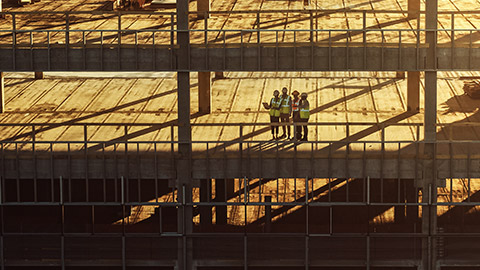
To properly document the results and other findings from the site inspection, you should correctly complete the workplace inspection report. To do this you need to do the following:
- Consult your site inspector: You should communicate with the inspector on the results and other information on the workplace inspection conduct in the construction site. As the inspector is the one who rates the site, the inspector will provide key recommendations to improve workplace health and safety and minimise risks and incidents.
- Provide accurate information and details: These include details of the project itself, the building company, its representatives, as well as key personnel that are affected by the results of the inspection (e.g. contractor, client, site manager, project manager, health and safety officers, etc.) and their respective roles and contact details. Details of the inspector should also be provided accurately in case of consultations and further inspections.
- Present objective data and results: You should present the findings of the workplace inspection as objectively as possible. Never manipulate the results, especially if you are going to do it to achieve compliance when this is not the case. Impartial results will aid in the improvement of health and safety aspects and features of the site, which will greatly benefit the project and its workers. On the other hand, false results will mislead people, thinking that the site adheres to health and safety requirements, but in reality, they are actually exposed to risks of hazards and harm.
- Be as detailed as possible with recommending actions: Detailed action steps will help achieve health and safety compliance quicker than just labelling some requirements as non-conformance or needs action/improvement. Specific recommendations help plan out what needs to be done in order to comply with health and safety requirements.
- Review results of workplace inspection and other relevant documents: This will guide you and anyone affected by the site inspection results to be able to recommend actions that will minimise incidents and mitigate risks in the construction site. Aside from the inspection report itself, you may review the inspection checklist, WHS legislation, building codes and standards, organisational policies on work health and safety, the project plan and the building plans and specifications.
At the end of the module, at the Additional Resources, you can access a Site inspection report template and a WHS Audit report template as well.
